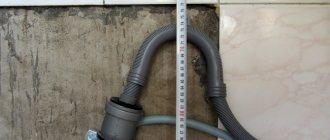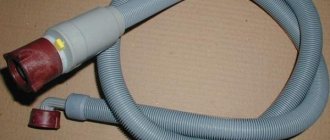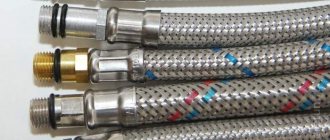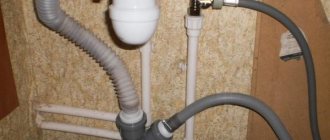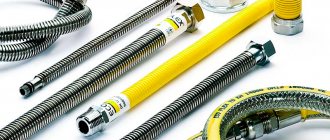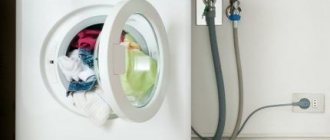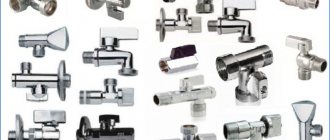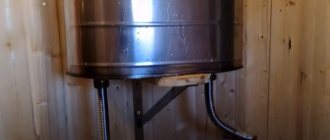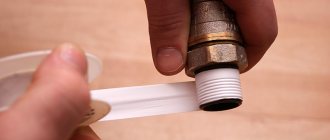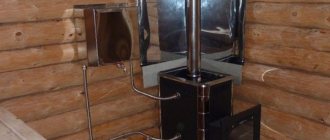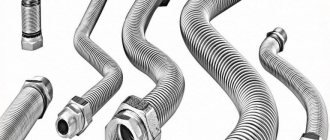Any household washing machine must be connected to a cold water supply and a sewer system to drain waste gray water. To connect to the water supply system, a separate hose for the washing machine is used, which comes with the unit; a second flexible line is used to send wastewater to the sewer.
In most washing machines, the water supply hose is not long enough to connect to the water supply - in this case, the consumer is faced with the task of choosing a suitable replacement from a number of similar or more technically equipped hoses. Sometimes the user has problems when the drain hose built into the washing machine is damaged; replacing it requires some technical knowledge.
Filling hoses for washing machines
Purpose of hoses for washing machines
A standard inlet hose for a washing machine is a smooth-walled polyvinyl chloride (PVC) tube up to 5 m long, reinforced on the inside with polyester, polyamide or nylon thread. Straight and corner fittings with sealing rubber gaskets made of PVC or polypropylene (PP) are pressed into the sleeve using aluminum sleeves along the edges. The filling hose has a diameter of 10 mm; plastic union nuts with an internal diameter of 3/4 inches are used to connect to the nozzles of the washing machine and water pipes.
It should be noted that many hoses for washing machines are used when connecting dishwashers to the water main.
The drain hose for a washing machine is a corrugated PVC tube designed to transport liquids with high temperatures. Depending on the brand of the washing machine, the diameters of its outer pipes have different sizes. The standard widths are 19 and 22 mm; in many imported models, the pipes have a diameter of 24 and 28 mm, and one of them may also have an angular design.
Connecting pipes for pressure hoses
Water hoses for washing machines perform the following functions:
- Supply cold water to the unit when washing clothes. To do this, one of the ends of the liner is equipped with a fitting with a rubber gasket, which is attached to the pipes using a union nut with an internal thread. During operation, the hose must withstand the maximum pressure in the water supply system, the standard value of which, according to GOST, is 6 bar.
- Gray waste is discharged into the sewer system after washing. To make draining into the bath easier, the end of the sleeve is placed in a horseshoe-shaped plastic guide.
- Thanks to the built-in filter, the inlet hose protects the washing machine from sand and dirt getting into its drum.
- Some models of modern supply hoses, in addition to transporting water to the washing machine, are capable of performing protective functions, preventing flooding of premises if the tightness of the system is broken or the supply line is broken.
Drain hoses - appearance and cost
Full protection
More advanced hose models are equipped with a valve with an electromagnetic sensor controlled by the microcontroller of the washing machine itself. This design will not allow leaks even in cases where damage occurs at the base of the hose inserted inside the device. The outer shell will prevent external leakage: leaked liquid will accumulate in the pan, which is equipped with a sensitive float.
When the sensor is triggered, the microcontroller will send a signal to the protection valve control unit, which will shut off the water. This protection option is implemented in almost all expensive models of washing machines of popular brands (BEKO, Bosch, LG, Siemens, Electrolux, etc.).
I work in the household appliance repair industry. Extensive experience in restoring washing machines and dishwashers.
Types of inlet hoses
The inlet hose for the washing machine, in addition to the drain hose built into its body, is always included in the delivery package, and the following types of pressure hoses are available:
- A simple single-layer tube made of durable rubber or polyvinyl chloride is the most budget option.
- Double-layer hoses reinforced with synthetic thread are the main types of hoses used in most washing machines. In some types of hoses, to increase strength and increase service life, the manufacturer strengthens the outer shell with nylon braid.
- Tubes with two shells for Aquastop systems. The inner one is a regular hose reinforced with synthetic thread, the outer one is an auxiliary element of the protection system and, depending on its type, performs different functions. In some types of leakage protection systems, an electric wire is laid between the shells, supplying control voltage to the Aquastop locking unit. In other designs, the second shell serves to supply water when the hose is damaged to the powder adsorbent associated with the shut-off valve.
Working principle of a mechanical valve
Aquastop systems for washing machines
Manufacturers of imported washing machines pay great attention to safety; their products are often equipped with automatic leakage protection systems. Aquastop systems built into washing machines come in several varieties, the main ones:
With mechanical valve . The main components of the Aquastop mechanical valve are a conical seat (gate) and a spring-loaded core, which in the operating position are at some distance from each other and water flows quietly through the gap between them. When the tube breaks, the speed of the water flow increases, the pressure behind the conical core drops, and it begins to move towards the valve until it completely blocks the water supply channel. A closed valve can only be returned to its operating position by equalizing the pressures at the inlet and outlet, so to restart you will have to turn off the water and unscrew the mechanical Aquastop valve.
The disadvantage of this device is that it reacts only to a complete break in the supply tube; with minor leaks and when water is simply dripping, the pressure drop is too small for the valve to operate.
Water Block - appearance and principle of operation
Water Block valve . This protection system works on the principle of dosing the volume of water consumed. A rotating mechanism is built inside the system that responds to the movement of water flow (an analogy can be made with a water meter).
Before starting the machine, the user sets on the device body the volume of water consumption for one wash; to do this, he rotates the moving part until it matches the desired digital symbol. Numbers from 1 to 10 indicate the volume of water consumed when the set value is multiplied by 5 liters.
When a water flow passes through the Water Block, the mechanism inside its body rotates, and as soon as the volume of flowing liquid reaches the set reading, the shut-off valve rises and instantly closes the water supply channel.
Appearance of a sleeve with Aquastop powder
Powder adsorbent. In this protection system, the hose consists of a double shell, the outer drainage has a corrugated structure. An adsorbent is located between the outer and inner walls, water is supplied to the washing machine through the central hose, and the locking unit is located near the inlet pipe of the hose.
If the inner tube is damaged, water enters the space between the hoses and reaches the adsorbent (to do this, the hose is installed with a slope towards the Aquastop unit), which expands in the presence of moisture. The powder is mechanically connected to the shut-off valve (plunger), so when the filler volume increases, the shut-off element moves and blocks the water inlet channel.
In other types of Aquastop powder systems, the shut-off valve is connected to a different-pole magnet, the same is placed in the adsorbent body; in operating condition, their mutual repulsive force is high and the passage channel is open. When the powder gets wet, it increases in volume, the distance between the magnets increases, the magnetic field weakens and the internal plunger blocks the passage channel.
A distinctive feature of these systems is the presence of a built-in peephole, by the color of which you can determine the presence of leaks if the hose is damaged.
Aquastop with adsorbent - internal structure
Float sensor . One of the most popular Aquastop systems, it reacts to flooding of premises in the event of a leak in the hose and washing machine, a break in the supply hose and other types of leaks. The operating principle of this device is to place a sensor on the washing tray, which is a foam float with a mechanical switch. The switch itself is connected by a wire to an electromagnetic coil, which is located in the supply hose housing next to the inlet pipe.
When the room is filled with water, the float floats up and closes the switch contacts. Power is supplied to the electromagnetic coil of the Aquastop system via an electric cable through a closed switch; its armature, together with the shut-off valve, moves and closes the inlet water channel.
The advantage of this system is protection against flooding of premises in the event of any type of leakage, so it is often used not only in washing machines, but also in dishwashers.
Float sensor - structural device
Purpose
You can reduce the likelihood of a leak by using a special hose equipped with the Aqua-Stop system. A similar inlet hose for a dishwasher is practically no different from a standard one; the difference lies in the use of special materials and the installation of an element that shuts off the water supply if a leak occurs. The purpose is as follows:
- Leak protection. A malfunctioning dishwasher can lead to a minor leak that will cause the room to fill with water.
- Automatic flow shut-off. The appearance of a leak leads to the fact that the protective device is activated without human intervention.
- Ensuring reliable operation of the equipment in question.
Modern dishwashers are completely protected from leaks. Manufacturers not only install an inlet hose with Aquastop, but also supply the machine body with a special tray with an electromechanical device. An integrated approach to protection allows you to achieve better results. The device works as follows:
- For various reasons, a leak occurs inside the dishwasher.
- The installed tray at the bottom of the structure is filled.
- When completely filled, a device is activated that closes the electrical target and shuts off the water.
How to choose hoses
When choosing an inlet hose for an automatic washing machine, pay attention to the following factors:
- When connecting the washing machine, the water supply hose must be in a freely lowered state without sharp bends, twists or loop bends. Therefore, to correctly determine its length, measure the distance from the inlet and outlet fittings and add 70 - 100 cm to the measured value (the height of the washing machine is added).
- All water supply pressure hoses for washing machines have a significant pressure reserve and are designed to work in systems with pressure from 10 to 70 bar; hoses with Aquastop have the highest hydraulic characteristics. Therefore, any hose is suitable for a regular washing machine, especially since the products have standard fittings with a union nut with an internal diameter of 3/4 inches for connecting the unit to the water supply system.
Aquastop hoses for working with a float sensor - a design device
- If it is necessary to extend the drain hose, then when purchasing you should pay attention to its temperature resistance. In some models, the extreme limit is 90 ° C, and if washing machines use the boiling function, the heat resistance of this sleeve may not be sufficient. To avoid problems with high temperatures of the drained water, select a hose with the appropriate parameters.
- To organize flood protection using the Aquastop system for washing machines that do not have a built-in float switch, a hose with a shut-off system made of powder adsorbent is often purchased. It should be taken into account that this design has low functionality and protects the premises from flooding only in the event of damage to the hose supply.
Washing machine connection diagram
Types of flexible water line
To connect water to a water consumer, two types of flexible lines are used:
Reinforced flexible liner
Reinforced flexible water supply hose.
Reinforced flexible hose is a flexible hose consisting of non-toxic rubber and covered on top with a reinforcing braid made of various materials. The mesh can be made of stainless steel, aluminum, galvanized metal or nylon braid . It is believed that a hose with nylon braid is guaranteed to fit any operating environment.
Bellows liner
Bellows liner hose.
Bellows flexible liners are steel rings that are seamlessly drawn or pressed under high pressure and welded together . The rings are made of stainless steel. Compared to rubber hoses with metal braiding, they are inferior in flexibility. Wall thickness is about 0.3 mm.
Causes of leaks
In order to prevent leaks when operating a washing machine, it is useful to know the main reasons causing this malfunction. These include:
- Damage to the casing of the falling pressure hose. Most often it is caused by mechanical stress, improper operation in too warm or cold rooms, or prolonged use, as a result of which the shell loses its elasticity and cracks appear in it. For any type of damage, the hose needs to be replaced; due to its low cost, there is no need for independent repairs.
- The filter built into the hose may become clogged. In this case, excess pressure often causes a leak to appear anywhere in the system. To carry out repairs, remove the hose and clean the filter, after which the liner is put back in place.
- Loosening of the clamping nuts and wear of gaskets can also cause leaks. To troubleshoot problems, the hose is disconnected, the gaskets are changed or the union nuts are tightened.
- Leaks can cause damage to your washing machine. Often, over time, internal water supply tubes lose their physical properties and water can penetrate into the room through cracks in their shell. Often, during operation, the rubber door gasket loses its elasticity, and water leaks through a loose connection. In these situations, washing machine repair specialists are called to troubleshoot problems.
Stages of replacing the drain hose
Choosing a location
First you need to decide on the location of the washing unit in the apartment. Modern models of machines require water supply and sewerage; they have a stationary type of placement, since moving them from one place to another is very difficult and makes no sense.
When determining the installation location, there are some factors to consider:
- Availability of water supply and sewerage systems nearby.
- Possibility of comfortable connection to the electrical network (it would be best to connect the device not through an extension cord, but from a simple cord).
- The presence of a flat (preferably reinforced concrete) floor.
- A good combination of the device and the surrounding interior of the room.
- Free access from all sides: in addition to easy loading of laundry, it is very important to have a gap on the wall side so that you can easily pick up clothes or other items that accidentally fall into the gap.
In everyday life, washing machines are usually located in the bathroom, hallway or kitchen.
The bathroom is a classic location for the machine, since this is where all the necessary communications are located, and it is easy to create a drain and water supply. The disadvantages of this arrangement include the small area of many bathtubs, which is why consumers have to buy more equipped models of machines. In addition, such a space is characterized by high humidity, which can adversely affect the electrical wiring of the machine and cause various malfunctions of the device.
The kitchen is also often used to install the device, which is most often located under the sinks or near the sink. Since this room is also very often small, washing in such conditions sometimes bothers the housewife. In addition, the temperature and humidity conditions in this place also do not always correspond to the rules for using washing machines.
The hallway area and other places in the house. A slightly unusual, but quite suitable place would be to install the device in a hallway, closet, in a spacious closet or utility room. The only drawback in this case will be the lack of quick and unhindered access to the communication system.
How to replace hoses
If the inlet hose is damaged, replacing it will not be difficult even for a schoolchild. To do this, purchase a product of similar length, remove the damaged sleeve by unscrewing the union nuts manually (do not forget to turn off the water supply ball valve), and connect the purchased product in its place.
The situation is more complicated if it is necessary to replace a drain hose that has been damaged during operation. Since the sleeves of many machines differ in their dimensional parameters, instead of the old one they usually purchase a product designed for a specific brand of washing machine (Electrolux, Samsung, Indesit).
Before changing the drain hose in the machine, disconnect it from the power supply, disconnect the pressure filling hose from the body, then carry out the following operations:
- Lay the car on its side and remove the back wall, unscrewing the fixing screws with a screwdriver.
- Determine the entry point of the drain hose into the water pump, and then remove its fastening by unscrewing the clamping clamp.
- Remove the old hose from the washing machine and take a new product. To install the drain hose in its place, insert the hose through the hole in the body, put it on the outlet pipe of the pump and clamp it with a clamp using a screwdriver.
- Upon completion of installation, install the back cover in place, screwing it in place.
Popular inlet hoses and their costs
Preparing for installation
The purchased washing machine is delivered to the buyer’s apartment already assembled. All important parts that rotate are fixed with special fasteners (brackets, bars and bolts), which prevent the machine from being accidentally damaged during transportation to the customer.
The delivered machine should be taken out of the box and begin to remove all fixing elements from it:
- The brackets that are installed to provide rigidity necessary when transporting heavy household appliances should be removed from the rear wall of the machine. These fasteners also support more flexible parts, such as the electrical cord and hose.
- Afterwards you need to get rid of unnecessary bars that are located between the drain tank and the body of the machine. To do this, simply tilt the washing machine forward.
- It is necessary to remove the bolts that are screwed into the front body of the machine to secure the drum. Plastic plugs must be immediately inserted into the holes from the removed bolts (in most cases they can be found included with the device).
Manufacturers
Almost all drain hoses sold in the retail chain are produced by washing machine manufacturers. The most famous of them are Bosch, Candy, Indesit, LG, Samsung, Electrolux, Atlant, Veko. Depending on the brand of the unit, each product has its own alphanumeric designation, indicating compliance with a specific model of the washing machine.
The situation is different with inlet hoses, the connecting dimensions of which are unified. The product is represented on the market by a wide range of domestic, Chinese, and European manufacturers. The most famous brands are Aquatechnic (Russia), Magic Power (China), Swedish Electrolux with aquastop, Turboflex (Russia), Reflex (Italy).
Modern inlet hoses for washing machines are capable of not only supplying water to the units, but also protecting the premises from flooding in the event of various types of leaks thanks to the built-in Aquastop systems. The consumer has the opportunity to choose any filler and drain hose that suits the model of his washing machine at an affordable price from a wide range of products from domestic and foreign manufacturers.
Dimensions of flexible water connection
Flexible line length
Flexible hose diameter
Flexible hose thread diameter
For household appliances and faucets, the connection sizes are different: 3/8 inch or M 10 for connecting faucets , then there are fittings measuring 1/2, 3/4 and 1 inch for connecting the rest of the equipment and filter system.
All necessary dimensions and characteristics of the flexible hose are indicated on the packaging or on a tag attached to the hose. The designation M 10 , for example, denotes the internal diameter of a thread of 9.5 mm in the metric system of measurements (as you can understand, rounding is used for convenience, up or down, so instead of 9.5 mm for a 3/8-inch thread, we see designation M 10, or in other words conventionally 10 mm, this designation also has the name Euro size), 1/2 inches is designated as M 12 at 12.7 mm, and so on.
Conversion table inches - mm - euro size.
Life time
The manufacturer prudently gives a small guarantee on its work - one to two years. In reality, the part can last five to ten years or more. A properly installed hose - without sharp kinks or kinks - will last longer. The absence of sudden temperature changes has a positive effect on its safety. If you close the water tap after each wash to reduce internal pressure, the rubber tube will wear out less.
To extend the life of the drain pipe, it is better to install it motionlessly, securing it with a cuff in the sewer pipe or siphon. Timely cleaning of filters prevents possible clogging and damage due to clogging. It is undesirable for any type of aggressive chemicals - acids and alkalis - to come into contact with the drain and fill pipes.
Correct connection of hoses is the key to stable and safe operation of the washing machine. Safety systems have been developed to protect against leaks. If, as a result of possible malfunctions in the operation of water-consuming devices, the property of strangers may be damaged, then you need to take the most responsible approach to solving the problem of leaks. Regular inspection and replacement of hoses and connecting elements will protect against sudden accidents.
